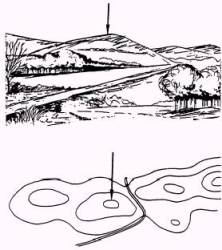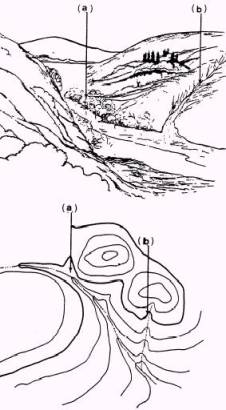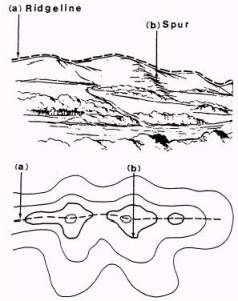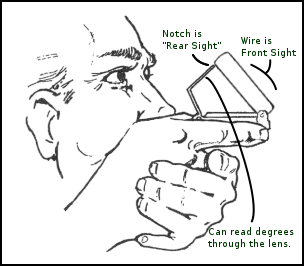This revision is from 2010/09/28 22:01. You can Restore it.
Basics(Edit)
Map Information(Edit)
- Hill, Valley, Saddle (Ridge, Depression aren't really on the course)
- Draw, Spur (no Cliffs)



- Note the way U- and V-shaped contour lines work these
- Be able to visualize the way contour lines will affect the ground---how the lines translate to a 3D image.
- The course has subtle terrain, but it can still be useful. Sometimes all you know is that the ground underneath you slopes in a particular direction, but that is something you can read from the contour lines.
- Know Index, Intermediate, Supplementary (and know the interval, which is 5m/line in this case)
- Colors:
- Know the Green vegetation, White clearing (Yes, they change a little over time, but they are surprisingly useful)
- Red-Brown contour lines
- Bench Mark (the ones that have actual survey markers)
Orientation(Edit)
- Usually you orienting according to real life (instead of insisting on always putting North at the top. Orient it so you are walking in the direction you are reading)
- Understand Magnetic North, Grid North, and the G-M angle (which is "Add 8 degrees to go from Grid to Magnetic" for the Hoffman course)
Know and practice with the Coordinate Scale

- Grid lines, Right Then Up (!) (the 4-digit grid "26 81" means "grid line 26 to the East, line 81 to the North")
- Decimal place, Right Then Up (!) (the 6-digit grid "263 819" means "300 meters East of 26, 900 meters North of 81")
- Same goes for 8-digit grids ("2631 8192" ... "310 meters E, 920 meters North")
- Always make sure the Coordinate Scale is not flipped over or upside down (read the words at the top right)
- Line up the 0's as your crosshairs, ignoring the plastic (sometimes the triangle cutout is too small, sometimes it is too big, but either way you ignore it and reference the "0"s)
- Plot and re-check everything, like the carpenters' "Measure Twice, Cut Once".
Compass(Edit)
- Degrees are in red, on the inner ring. Ignore the mils (in black) on the outside. Those Mils, they Kills!
- If you get momentarily confused, you can use common sense. If you are shooting an azimuth towards the South and it says "32", then you are looking at 3200 mils, not 32 degrees. Instead look for the number closer to 180.
- 3 degrees per bezel ring click
- Use the cheek-hold technique for a more accurate shot:

- Get good at "Compass Quickdraw". There are different ways to do it, but make sure your compass is accessible and that you practice drawing/replacing it quickly to encourage frequent checks.
Pace Count(Edit)
- Use beads (A good way is to by hobby beads (e.g., from Wal-Mart) and thread them over 550 cord that is folded double with the white strings (guts) pulled out. This is just the right amount of tension without being very difficult to thread.)
- Understand how fatigue, terrain, load, etc., add steps to your 100m count.
Moving up(Edit)
Route Planning!
- Have several checkpoints per klick (1000m) to make sure you're on track.
- Handrail, Backstop
- Draws. The Hoffman course is all about those overgrown draws.
- Don't bust 'em, if you can avoid it---especially at night.
- Close contour lines mean steep ground which means less water pooling which means less vegetation which means a better place to bust draws.
- Find the weak spots by handrailing them on your way around. Worst-case: you walk all the way around, Best case: you find a good crossing.
- For practice, try writing everything down, and review it with a buddy. By the time you get to the real thing, you should be comfortable enough with Route Planning that you can just do it in your head every time.
- Try to use the gentler sloped terrain (contour lines are further apart)
- Basically, you'll be bouncing between intersections of roads, draws, clearings, etc., as you head in the general direction of your point.
Plan an Attack Point
- As close to the objective as possible, hopefully well under 300m.
- Should be a solid terrain feature or landmark so that if you can't find your point on the final approach you can just backtrack to the Attack Point and re-shoot.
- From the Attack Point to Objective is the only time you'll really use Dead Reckoning (travelling a specific distance and direction.) Otherwise it's all estimates and hitting landmarks.
- SLLS (Stop, Look, Listen, Smell) for your points. The point-sitters are crafty foxen.
- Smart search patterns. If you intentionally "aim off" right you only have to search to the left.
- A terrain feature beyond your objective that signals when you've gone too far.
Use Corridors and Handrails--like Backstops but to the sides.
- If you hit one you've veered to far, time to bounce back the other direction.
Handrail the roads
- Not too close, you don't want to violate the rules.
- This is really a kind of Corridor.
Make up time by moving out when you're on nonrestrictive terrain.
- You have to get aggressive, stay aggressive, and refuse to cut yourself a moments' slack.
- Don't forget to think. They say, "Land nav. is a thinking man's game. If you're not thinking about something, you're wrong." So don't get so distracted by the idea of moving quickly that you move in error.
Rule the Night.
- A majority of your time is during the dark hours.
- Don't get discouraged or think it's good strategy to wait until day--the chemlights actually make finding some night time points easier.
- You're going to get a little beat up and discouraged. Just push through.
Cross Draws intelligently
- Look for the narrowness around the contour lines surrounding the draw. They indicate higher ground (and less water pooling, thus less vegetation).
- Find places where other candidates have gone through. They exist, you just have to be patient enough to find them. Worst case you go all the way around the draw, but you probably can spot a good crossing before that.
- If you bust a draw at night you're either more awesome or more stupid than me.
Check your compass frequently when going through a draw. Like every 20 steps. It is possible to fight for an hour to end up where you started
Landmarks!
- Before exam day, you should at least know where these are:
- The TOC
- 3-wire Road
- 4-wire Road
- Puppy Palace
- Bowling Alley (plus the road that leads out of it to the North)
- Six Corners
- Five Corners (on the East)
- Lake Bagget (and its authorized crossing)
- Scuba Road (and its dry crossing)
- Lookout tower to the West
- "Dagobah", a.k.a., "The Great Lost North"
- Jurassic Park--the draw to the East
- Note all Happy Stakes. They are engineer stakes with a dogtag with a grid coordinate.
- If you observe them during the practice you can remember the spots later on
- They are better than GPS. There is no load time and they don't lose track of their satellites.
- Possibly useful, but you should know anyway: Intersection, Resection
Additional Topics(Edit)
These aren't essential for navigating the course, but they might come in handy.
- Back Azimuth
- True North
General Advice(Edit)
Maximize the training time.
- Numerous practical exercises
- Numerous classes
- Unlimited time sitting around with maps and buddies. Find the motivated candidates that want to talk about Route Planning or their experiences with specific draws and landmarks.
Judiciously Mark the Map
- Don't overmark--you'll cover good information.
- Don't undermark--you might be surprised how well you remember a specific moment from before if you leave the right notes.
Tie your map/compass/everything down.
Don't get Injured
Battle Fatigue and Doubt
- Don't make stupid mistakes.
- Don't give in.
- You will make stupid mistakes--how will you react? Don't give in.
(Edit)